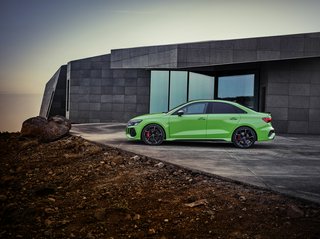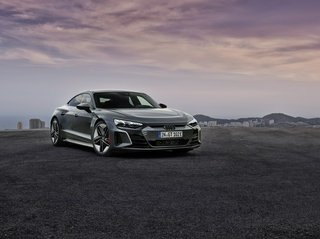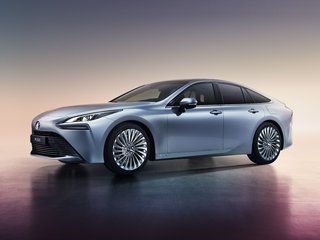Compare Audi RS 3 (8Y) Sedan vs Audi e-tron GT vs Toyota Mirai 2
Variants
e-tron GT quattro
RS e-tron GT
Capacity
Cargo Capacity
321 L / 11.3 cu-ft
Coolant Capacity
9.8 L / 10.4 qt
Engine Oil Capacity
7.1 L / 7.5 qt
Fuel Capacity
55.0 L / 14.5 gal
5.6 L / 1.5 gal
Passengers
5
4
5
Payload
505 kg / 1113 lbs
465 kg / 1025 lbs
Chassis
Brakes | Front
Ventilated discs, 375x36 mm
Ventilated discs
Brakes | Rear
Ventilated discs, 310x22 mm
Ventilated discs
Offroad | Approach Angle
13.0 deg
Offroad | Departure Angle
16.4 deg
Power Steering
Electric Steering
Electric Steering
Electric Steering
Suspension | Front
MacPherson strut
Double-wishbone
Multi-link
Suspension | Rear
Multi-link
Multi-link
Multi-link
Tire Size
Front wheel tires: 245/35 R19 Rear wheel tires: 265/30 R19
235/55 R19, 245/45 R20
Turning Circle
12.0 m / 39.4 ft
11.6 m / 38.0 ft
12.6 m / 41.3 ft
Construction
Battery | Capacity
93.4 kWh (gross) | 83.7 kWh (net)
1.2 kWh (gross)
Battery | Type
Lithium-ion
Lithium-ion
Battery | Voltage
310.8 V
Body Style
4-door Sedan
4-door battery-electric Sedan
4-door hydrogen fuel cell Sedan
Dimensions
Ground Clearance
150 mm / 5.9 in
Size | Height
1412 mm / 55.6 in
1480 mm / 58.3 in
Size | Length
4542 mm / 178.8 in
4989 mm / 196.4 in
4975 mm / 195.9 in
Size | Width
1851 mm / 72.9 in | 1984 mm / 78.1 in (mirror unfolded)
1964 mm / 77.3 in | 2158 mm / 85.0 in (mirror unfolded)
1885 mm / 74.2 in
Track Width | Front
1592.0 mm / 62.7 in
1610.0 mm / 63.4 in
Track Width | Rear
1524.0 mm / 60.0 in
1605.0 mm / 63.2 in
Weight
1575.0 kg / 3472.3 lbs
1900.0 kg / 4188.8 lbs
Wheel Size
Front wheel rims: 8J x 19 Rear wheel rims: 9J x 19
8.0J x 19, 8.5J x 20
Wheelbase
2631 mm / 103.6 in
2920 mm / 115.0 in
Performance
Acceleration | 0 - 100 km/h
3.8 sec
9.2 sec
Acceleration | 0 - 60 mph
3.6 sec
8.7 sec
CO2 Emission
188 ~ 198 g/km
Coefficient Of Drag
0.32
0.24
0.29
Fuel Economy
8.2 L/100km / 28.7 MPG (combined) | 11.1 L/100km / 21.2 MPG (urban) | 6.5 L/100km / 36.2 MPG (highway)
Top Speed
250.0 km/h / 155.3 mph
175.0 km/h / 108.7 mph
Powertrain
Drivetrain Layout
Front-engine (transverse), All-wheel drive
Rear-engine (transverse), All-wheel drive
Rear-engine (transverse), Rear-wheel drive
Emission Standard
Euro 6 d-ISC-FCM
Engine
DNW
Engine | Bore
82.5 mm / 3.2 in
Engine | Compression Ratio
10.0:1
Engine | Displacement
2.5 L / 151.3 cu-in / 2480.0 cc
Engine | Power
400.0 hp / 298.3 kW @ 5600-7000 rpm
182 hp / 135.7 kW
Engine | Specific Output
161.3 hp/L / 2.6 hp/cu-in
Engine | Stroke
92.8 mm / 3.7 in
Engine | Torque
500 Nm / 368.8 lb-ft @ 2250-5600 rpm
Engine | Type
Turbocharged direct-injected petrol inline-5 DOHC engine with 4 values per cylinder
hydrogen engine
Transmission | Gears
7-speed
2-speed
1-speed
Transmission | Type
Automatic S tronic
Automatic
Automatic
Production
Availability
2021
2021
2020
Debut
2021-02-09
Made In
Germany
Reviews
Neofiliac score
54%
75%
62%
Pros
- Decent performance
- Exclusive access to the inline-5 engine
- Good performance
- Up to 452km electric range
- Excellent 0.24 drag coefficient
- Rather good exterior styling
- Powered by zero-emission hydrogen fuel cell
- Good 0.28 drag coefficient
- Great styling
Cons
- Stuck with MacPherson struts in the front
- Rather weird proportions
- EV nonsense
- Loaded with electronic BS
- Low performance
- Lack of hydrogen infrastructure
Remove
Remove
Remove
Add up to 4 products to the comparison using the search bar above
Information on this page is provided on an as-is basis. No warranty on accuracy is implied. This page may contain affiliate links to third-party merchants such as Amazon and eBay. If you make a purchase using the supplied link, we may receive a commission. Neofiliac places the utmost respect for your privacy. We use no cookie whatsoever beyond that needed for the proper functioning of the website.


